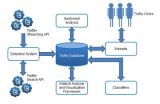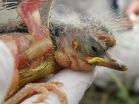(Press-News.org) When the scientific and spiritual worlds collide, they do so in the most surprising ways. Classical meteorological and plant science has, in the last century, insisted that dew negatively affects plant life, leading to rot and fungus. But in the Judeo-Christian tradition, dew is most welcomed as an important source of vegetative and plant life, celebrated in poetry and prayer.
Now Prof. Pinhas Alpert of Tel Aviv University's Department of Geophysics and Planetary Sciences has developed an explanation for the perplexing paradox with his colleagues. According to scientific literature, he says, dew that accumulates through the night has a negative effect on vegetation and fruits because it creates a "spongy" effect. But in a recent issue of the Water Resources Journal, Prof. Alpert demonstrates that dew is an important water source for plant life in climates such as those in the Eastern Mediterranean, where the Judeo-Christian tradition originated, and parts of the U.S. Great Basin Desert.
"Semi-arid zones are dry for over half the year," he explains. "Dew is therefore an important source of moisture in the air. It surrounds the plant leaves nearly every morning for approximately two to three hours past sunrise." This finding, he says, explains why dew is such an important part of Judaeo-Christian traditions. In Judaism, blessings are offered to rain and dew in daily prayer, and there are many references to dew throughout the Bible, including the Old Testament books of Genesis and Isaiah.
Creating the ideal conditions for growth
A plant's growth is based on photosynthesis, employing stomata, the small openings in vegetation and fruit leaves that absorb carbon dioxide. The combination of water, carbon dioxide in the air and sunlight help a plant to produce sugars which allow it to grow. In temperate zones, most of a plant's growth occurs in the middle of the day, when the most sunlight is available.
But there are climatic influences as well. According to Prof. Alpert, plants in a semi-arid zone close these stomatic openings in the midday as a defence mechanism, to avoid losing moisture, or in other words water, when the weather is at its driest. When this happens, photosynthesis and plant growth cannot take place.
For these reasons, the early-morning hours -- and not those of midday -- are the period of maximum growth for plants in the Eastern Mediterranean region, Prof. Alpert says. And it's all due to the dew. "In the early morning, dew surrounds the leaves of a plant with moisture, and the plant does not close its stomata. Therefore, it can grow."
Biblical dew
In order to research the effect of dew on plant life, Prof. Alpert and his fellow scientists studied the interaction between the leaves of a plant and the air. They measured how much moisture departs from the leaves and how much carbon dioxide enters them at various times of the day.
These findings explain a very old paradox, says Prof. Alpert. Despite its negative reputation in other climates, dew is idealized in the Bible for its ability to help fruits and vegetables grow in a dry and inhospitable region -- like the Eastern Mediterranean, where the books of the Bible were first collected.
INFORMATION:
American Friends of Tel Aviv University (www.aftau.org) supports Israel's leading, most comprehensive and most sought-after center of higher learning. Ranking 94th among the world's top universities for the impact of its research, TAU's innovations and discoveries are cited more often by the global scientific community than all but 10 other universities.
Internationally recognized for the scope and groundbreaking nature of its research and scholarship, Tel Aviv University consistently produces work with profound implications for the future.
The dual nature of dew
Tel Aviv University measures the effect of dew on desert plants
2010-09-29
ELSE PRESS RELEASES FROM THIS DATE:
Noise and chemicals: Workers are losing their hearing
2010-09-29
A study carried out by Spanish researchers has shown that the presence of chemical contaminants can interact with noise and modify, for good or for bad, the way in which work-related "deafness" – which is increasingly common among young people – manifests itself. Noise-related hearing loss is the most common occupational disease in Europe.
"Workers exposed to noise in the presence of metalworking fluids exhibit a delay in hearing alteration in comparison with those exposed only to noise at the same intensity. However, those exposed to noise in the presence of welding ...
Truthy.indiana.edu to search, identify smear tactics, Twitter-bombs through election runup
2010-09-29
Astroturfers, Twitter-bombers and smear campaigners need beware this election season as a group of leading Indiana University information and computer scientists today unleashed Truthy.indiana.edu, a sophisticated new Twitter-based research tool that combines data mining, social network analysis and crowdsourcing to uncover deceptive tactics and misinformation leading up to the Nov. 2 elections.
Combing through thousands of tweets per hour in search of political keywords, the team based out of IU's School of Informatics and Computing will isolate patterns of interest ...
Immunization coverage key to good health locally, globally
2010-09-29
FORT WORTH, TEXAS, USA, September 28, 2010—The outbreak of whooping cough in Texas, California, and other states this year underscores the critical importance of widespread vaccination coverage, both locally as well as around the world, said a leading global health official attending conferences on world affairs and immunization in Fort Worth this week.
Alex Palacios, a special representative of the GAVI Alliance, a public-private partnership aimed at increasing immunisation rates in poor countries, said that despite public health advances in the US and other wealthy countries ...
Tracking down pathogenic yeasts
2010-09-29
More than half of all people are hosts to Candida albicans in their bodies. This species might be located on their skin or mucous membranes or in the intestines – frequently without causing any symptoms. However, it can be dangerous to patients whose immunological system has been weakened such as after organ transplants or chemotherapy with cancer. Then, this fungus penetrates into deeper layers of tissue and uses the blood system to spread throughout the body. In Germany alone, several thousand people die from systemic candida infections every year.
But why does Candida ...
Understanding Missouri River's sediment dynamics key to protecting endangered species
2010-09-29
Sept. 28, 2010 -- A new report from the National Research Council says that more organized and systematic procedures for gathering and evaluating data on Missouri River sediment are required to improve decisions and better manage the river's ecosystem, including protecting endangered species and developing water quality standards. In addition, the report finds that the U.S. Army Corps of Engineers' projects to restore habitats along the Missouri River are not significantly changing the size of the oxygen-depleted "dead zone" in the Gulf of Mexico, nor will options for ...
Wheel in a corset
2010-09-29
Just imagine your car suddenly comes to a halt on a quiet country road, and it's only four years old. This is not a pleasant thought. A breakdown is expensive. Not to mention the safety risk to the occupants – because the breakdown was caused by the extremely light plastic wheels so highly praised by the car salesman. One of them has broken. »Such a scenario must, of course, never happen in reality,« states Prof. Dr.-Ing. Andreas Büter from the Fraunhofer Institute for Structural Durability and System Reliability LBF in Darmstadt. The experts there specialize in operational ...
Study finds potential climate change side effect: More parasites on South American birds
2010-09-29
A Wildlife Conservation Society (WCS) study on nesting birds in Argentina finds that increasing temperatures and rainfall—both side effects of climate change in some parts of the world—could be bad for birds of South America, but great for some of their parasites which thrive in warmer and wetter conditions.
The study, which looked at nesting forest birds in Santa Fe, Argentina, found that increases in temperature and precipitation produce a bumper crop of parasitic fly larvae of the species Philornis torquans, parasites that burrow into the skin of baby birds to feed. ...
Why we fight: Men check out in stressful situations
2010-09-29
A new study by USC researchers reveals that stressed men looking at angry faces had diminished activity in the brain regions responsible for understanding others' feelings.
Turns out the silent and stoic response to stress might be a guy thing after all.
"These are the first findings to indicate that sex differences in the effects of stress on social behavior extend to one of the most basic social transactions — processing someone else's facial expression," said Mara Mather, director of the Emotion and Cognition Lab at USC.
In an article appearing the October 6 issue ...
Assessment of US doctoral programs released, offers data on more than 5,000 programs nationwide
2010-09-29
Sept. 28, 2010 — The National Research Council today released its assessment of U.S. doctoral programs, which includes data on over 5,000 programs in 62 fields at 212 universities nationwide. The assessment is designed to help universities evaluate and improve the quality of their programs and to provide prospective students with information on the nation's doctoral programs. (See Full Report)
"This report and its large collection of quantitative data will become in our view an important and transparent instrument for strengthening doctoral education in the United States," ...
Pet allergies worsen hay fever symptoms, Queen's study finds
2010-09-29
Being allergic to dogs or cats may worsen your ragweed allergies, according to a study from Queen's University.
Researchers found that people with pet allergies often develop ragweed allergy symptoms more quickly than others. But the study also suggests that once allergy season is in full swing, those symptom differences subside.
The team, led by Anne Ellis, an assistant professor in the departments of medicine and microbiology & immunology, exposed 123 participants to ragweed, and noted that pet allergy sufferers reported symptoms differently than their non-animal ...
LAST 30 PRESS RELEASES:
S-species-stimulated deep reconstruction of ultra-homogeneous CuS nanosheets for efficient HMF electrooxidation
Mechanical and corrosion behavior of additively manufactured NiTi shape memory alloys
New discovery rewrites the rules of antigen presentation
Researchers achieve chain-length control of fatty acid biosynthesis in yeast
Water interactions in molecular sieve catalysis: Framework evolution and reaction modulation
Shark biology breakthrough: Study tracks tiger sharks to Maui mating hub
Mysterious iron ‘bar’ discovered in famous nebula
World-first tool reduces harmful engagement with AI-generated explicit images
Learning about public consensus on climate change does little to boost people’s support for action, study shows
Sylvester Cancer Tip Sheet for January 2026
The Global Ocean Ship-Based Hydrographic Investigations Program (GO-SHIP) receives the Ocean Observing Team Award
Elva Escobar Briones selected for The Oceanography Society Mentoring Award
Why a life-threatening sedative is being prescribed more often for seniors
Findings suggest that certain medications for Type 2 diabetes reduce risk of dementia
UC Riverside scientists win 2025 Buchalter Cosmology Prize
SETI Institute opens call for nominations for the 2026 Tarter Award
Novel theranostic model shows curative potential for gastric and pancreatic tumors
How beige fat keeps blood pressure in check
Fossils reveal ‘latitudinal traps’ that increased extinction risk for marine species
Review: The opportunities and risks of AI in mental health research and care
New map reveals features of Antarctic’s ice-covered landscape
Beige fat promotes healthy vascular function and blood pressure in mice
Chronic low-dose pesticide exposure reduces the life span of wild lake fish, China-based study shows
Tiny earthquakes reveal hidden faults under Northern California
Long-term pesticide exposure accelerates aging and shortens lifespan in fish
Professor Tae-Woo Lee's research group develops groundbreaking perovskite display technology demonstrating the highest efficiency and industry-level operational lifetime
The “broker” family helps tidy up the cell
Ecology: Mummified cheetahs discovery gives hope for species’ Arabic reintroduction
Researchers survey the ADHD coaching boom
Air pollution and cardiac remodeling and function in patients with breast cancer
[Press-News.org] The dual nature of dewTel Aviv University measures the effect of dew on desert plants




